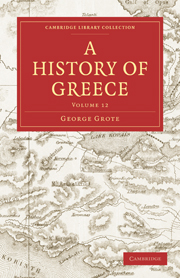Book contents
- Frontmatter
- Contents
- CHAPTER XCI First Period of the Reign of Alexander the Great—Siege and Capture of Thebes
- CHAPTER XCII Asiatic Campaigns of Alexander
- CHAPTER XCIII Second and Third Asiatic Campaigns of Alexander—Battle of Issus—Siege of Tyre
- CHAPTER XCIV Military Operations and Conquests of Alexander, after his Winter-Quarters in Persis, down to his Death at Babylon
- CHAPTER XCV Grecian Affairs from the Landing of Alexander in Asia to the close of the Lamian War
- CHAPTER XCVI From the Lamian War to the close of the History of Free Hellas and Hellenism
- CHAPTER XCVII Sicilian and Italian Greeks—Agathokles
- CHAPTER XCVIII Outlying Hellenic Cities.—1. In Gaul and Spain. 2. On the coast of the Euxine
- INDEX
- Plate section
CHAPTER XCVII - Sicilian and Italian Greeks—Agathokles
Published online by Cambridge University Press: 05 March 2012
- Frontmatter
- Contents
- CHAPTER XCI First Period of the Reign of Alexander the Great—Siege and Capture of Thebes
- CHAPTER XCII Asiatic Campaigns of Alexander
- CHAPTER XCIII Second and Third Asiatic Campaigns of Alexander—Battle of Issus—Siege of Tyre
- CHAPTER XCIV Military Operations and Conquests of Alexander, after his Winter-Quarters in Persis, down to his Death at Babylon
- CHAPTER XCV Grecian Affairs from the Landing of Alexander in Asia to the close of the Lamian War
- CHAPTER XCVI From the Lamian War to the close of the History of Free Hellas and Hellenism
- CHAPTER XCVII Sicilian and Italian Greeks—Agathokles
- CHAPTER XCVIII Outlying Hellenic Cities.—1. In Gaul and Spain. 2. On the coast of the Euxine
- INDEX
- Plate section
Summary
Constitution established by Timoleon at Syracuse—afterwards exchanged for an oligarchy
It has been convenient, throughout all this work, to keep the history of the Italian and Sicilian Greeks distinct from that of the Central and Asiatic. We parted last from the Sicilian Greeks1, at the death of their champion the Corinthian Timoleon (337 B.C.), by whose energetic exploits, and generous political policy, they had been almost regenerated—rescued from foreign enemies, protected against intestine discord, and invigorated by a large reinforcement of new colonists. For the twenty years next succeeding the death of Timoleon, the history of Syracuse and Sicily is an absolute blank; which is deeply to be regretted, since the position of these cities included so much novelty—so many subjects for debate, for peremptory settlement, orfor amicable compromise—that the annals of their proceedings must have been peculiarly interesting. Twenty years after the death of Timoleon, we find the government of Syracuse described as an oligarchy; implying that the constitution established by Timoleon must have been changed either by violence or by consent. The oligarchy is stated as consisting of 600 chief men, among whom Sosistratus and Herakleides appear as leaders2. We hear generally that the Syracusans had been engaged in wars, and that Sosistratus either first originated, or first firmly established, his oligarchy, after an expedition undertaken to the coast of Italy, to assist the citizens of Kroton against their interior neighbours and assailants the Bruttians.
- Type
- Chapter
- Information
- A History of Greece , pp. 531 - 612Publisher: Cambridge University PressPrint publication year: 2010First published in: 1856

